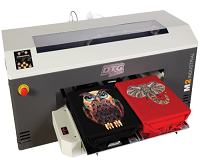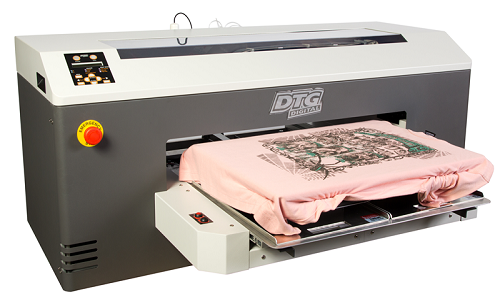"A T-shirt manufacturing factory proved to be the torchbearer for digital printing technology and DTG (direct to garment) printing that facilitated customised manufacturing. Today, multiple textile technologies offer a sustainable option to conventional production. They rationalise workflow besides offering the client “just in time” manufacturing. The traditional textile model is risky as both the manufacturer and retailer are unreasonably exposed during all cycles of this model, be it speed to market, value of stock, or consumer relevance."
 A T-shirt manufacturing factory proved to be the torchbearer for digital printing technology and DTG (direct to garment) printing that facilitated customised manufacturing. Today, multiple textile technologies offer a sustainable option to conventional production. They rationalise workflow besides offering the client “just in time” manufacturing. The traditional textile model is risky as both the manufacturer and retailer are unreasonably exposed during all cycles of this model, be it speed to market, value of stock, or consumer relevance. Also, the market uses extended financial credit lines which leads to reduced yields and offers a meager return on investment. As a result, profits grow slightly; stock grows in line with profits, until the time is reached when all of the profit is in the stock.
A T-shirt manufacturing factory proved to be the torchbearer for digital printing technology and DTG (direct to garment) printing that facilitated customised manufacturing. Today, multiple textile technologies offer a sustainable option to conventional production. They rationalise workflow besides offering the client “just in time” manufacturing. The traditional textile model is risky as both the manufacturer and retailer are unreasonably exposed during all cycles of this model, be it speed to market, value of stock, or consumer relevance. Also, the market uses extended financial credit lines which leads to reduced yields and offers a meager return on investment. As a result, profits grow slightly; stock grows in line with profits, until the time is reached when all of the profit is in the stock.
Providing a way forward
The Digital Textile Revolution including developments in CAD/CAM, augmented reality software, online workflow, laser cutting, and digital textile printing are providing a way forward that is not only risk free but also consumes fewer resources.
workflow, laser cutting, and digital textile printing are providing a way forward that is not only risk free but also consumes fewer resources.
The micro-factory model of “Sell, Produce, Deliver,” and not “Produce, Sell, Deliver” is driven by an online sales presence, alongside AR and AI software. The client selects buys and pays for their product before the item is produced. The model is capable of producing and delivering in 24 hours through n the speed of image processing, computerised workflow, digital printing and cutting and with computerised sewing (as an option) then dispatch,
This business model was first used by direct to garment (DTG) printers, who would deliver a sale within 24 hours of receiving the payment. The producer was able to cater to its consumers demands by creating and approving artwork, sending it to print, then packing and dispatching the blank t-shirts within the timeframe expected by the customer. The model has grown to encompass and attract many other sectors, with athleisure, swimwear and fashion taking up the opportunity to rationalise their production systems.
The online e-commerce tool in this model uses all the visual space of the selling website to make an extended offer in terms of product, color, size and design. When online orders are received, they immediately go into a computerised workflow, where the artwork is completed, the customer contacted and, upon approval, the production is initiated, all within a matter of minutes.
Adaptability with efficiency and profitability
The micro-factory produces textiles by using digital textile printing. The machinery is a fraction of the size of traditional machinery and also smaller in dimension. It consumes lesser heat, light, water and power than the traditional textile manufacturing model.
The micro-factory model is infinitely adaptive. A huge online range can be serviced efficiently and profitably, without enormous warehouses, without the risk of clearances, and without the uneconomic use of scarce cash reserves. It’s no wonder then, that the model is hailed as a new dawn for textiles, with its efficiency and profitability bringing manufacturing back to a more local base and offering jobs for workers in the country of origin.












